Pratik Narang
HAEPO: History-Aggregated Exploratory Policy Optimization
Aug 26, 2025Abstract:Exploration is essential in modern learning, from reinforcement learning environments with small neural policies to large language models (LLMs). Existing work, such as DPO, leverages full sequence log-likelihoods to capture an entire trajectory of the model's decisions, while methods like GRPO aggregate per-token ratios into a trajectory-level update. However, both often limit exploration on long-horizon tasks. We introduce History-Aggregated Exploratory Policy Optimization (HAEPO), a history-aware exploratory loss to combat these shortcomings. HAEPO compresses each trajectory into the sum of its logarithmic probabilities (a cumulative logarithmic likelihood), and applies a Plackett-Luce softmax across trajectories to obtain normalized weights proportional to their returns, thus encouraging broader exploration. We add entropy regularization to stabilize the aggressive updates to prevent premature collapse and a soft KL penalty relative to a frozen copy of the previous (reference) policy. Empirically, HAEPO converges fast, explores thoroughly, aligns closely with true rewards, and demonstrates robust learning behavior better or at par with PPO, GRPO, and DPO across diverse tasks. Thus, HAEPO provides a stable and interpretable framework by explicitly leveraging full-trajectory history while balancing exploration and stability.
Balancing the Scales: Enhancing Fairness in Facial Expression Recognition with Latent Alignment
Oct 25, 2024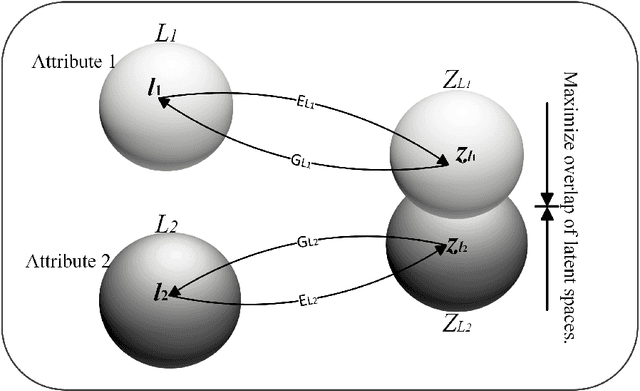
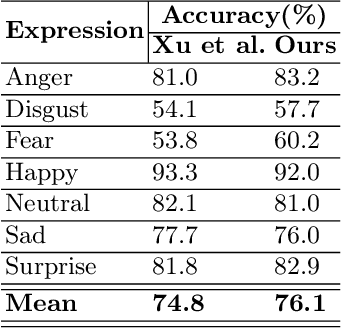
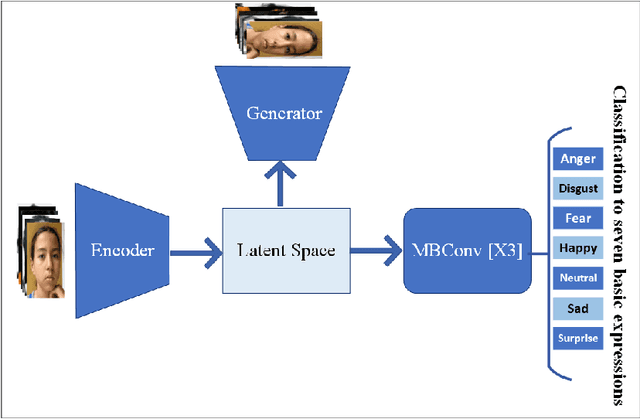

Abstract:Automatically recognizing emotional intent using facial expression has been a thoroughly investigated topic in the realm of computer vision. Facial Expression Recognition (FER), being a supervised learning task, relies heavily on substantially large data exemplifying various socio-cultural demographic attributes. Over the past decade, several real-world in-the-wild FER datasets that have been proposed were collected through crowd-sourcing or web-scraping. However, most of these practically used datasets employ a manual annotation methodology for labeling emotional intent, which inherently propagates individual demographic biases. Moreover, these datasets also lack an equitable representation of various socio-cultural demographic groups, thereby inducing a class imbalance. Bias analysis and its mitigation have been investigated across multiple domains and problem settings, however, in the FER domain, this is a relatively lesser explored area. This work leverages representation learning based on latent spaces to mitigate bias in facial expression recognition systems, thereby enhancing a deep learning model's fairness and overall accuracy.
LDFaceNet: Latent Diffusion-based Network for High-Fidelity Deepfake Generation
Aug 04, 2024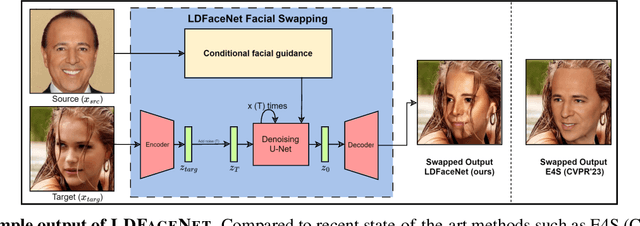


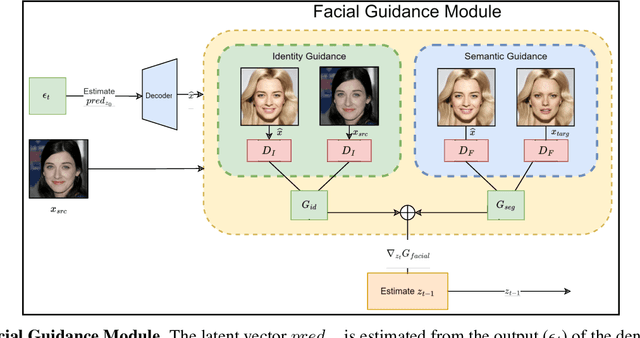
Abstract:Over the past decade, there has been tremendous progress in the domain of synthetic media generation. This is mainly due to the powerful methods based on generative adversarial networks (GANs). Very recently, diffusion probabilistic models, which are inspired by non-equilibrium thermodynamics, have taken the spotlight. In the realm of image generation, diffusion models (DMs) have exhibited remarkable proficiency in producing both realistic and heterogeneous imagery through their stochastic sampling procedure. This paper proposes a novel facial swapping module, termed as LDFaceNet (Latent Diffusion based Face Swapping Network), which is based on a guided latent diffusion model that utilizes facial segmentation and facial recognition modules for a conditioned denoising process. The model employs a unique loss function to offer directional guidance to the diffusion process. Notably, LDFaceNet can incorporate supplementary facial guidance for desired outcomes without any retraining. To the best of our knowledge, this represents the first application of the latent diffusion model in the face-swapping task without prior training. The results of this study demonstrate that the proposed method can generate extremely realistic and coherent images by leveraging the potential of the diffusion model for facial swapping, thereby yielding superior visual outcomes and greater diversity.
InFER: A Multi-Ethnic Indian Facial Expression Recognition Dataset
Sep 30, 2023
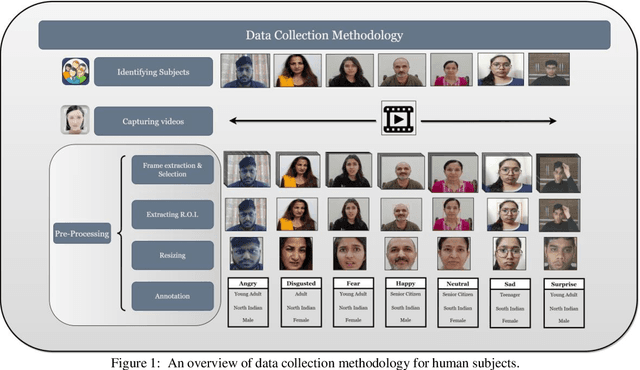


Abstract:The rapid advancement in deep learning over the past decade has transformed Facial Expression Recognition (FER) systems, as newer methods have been proposed that outperform the existing traditional handcrafted techniques. However, such a supervised learning approach requires a sufficiently large training dataset covering all the possible scenarios. And since most people exhibit facial expressions based upon their age group, gender, and ethnicity, a diverse facial expression dataset is needed. This becomes even more crucial while developing a FER system for the Indian subcontinent, which comprises of a diverse multi-ethnic population. In this work, we present InFER, a real-world multi-ethnic Indian Facial Expression Recognition dataset consisting of 10,200 images and 4,200 short videos of seven basic facial expressions. The dataset has posed expressions of 600 human subjects, and spontaneous/acted expressions of 6000 images crowd-sourced from the internet. To the best of our knowledge InFER is the first of its kind consisting of images from 600 subjects from very diverse ethnicity of the Indian Subcontinent. We also present the experimental results of baseline & deep FER methods on our dataset to substantiate its usability in real-world practical applications.
* In Proceedings of the 15th International Conference on Agents and Artificial Intelligence Volume 3: ICAART; ISBN 978-989-758-623-1; ISSN 2184-433X, SciTePress, pages 550-557. DOI: 10.5220/0011699400003393
LVRNet: Lightweight Image Restoration for Aerial Images under Low Visibility
Jan 13, 2023Abstract:Learning to recover clear images from images having a combination of degrading factors is a challenging task. That being said, autonomous surveillance in low visibility conditions caused by high pollution/smoke, poor air quality index, low light, atmospheric scattering, and haze during a blizzard becomes even more important to prevent accidents. It is thus crucial to form a solution that can result in a high-quality image and is efficient enough to be deployed for everyday use. However, the lack of proper datasets available to tackle this task limits the performance of the previous methods proposed. To this end, we generate the LowVis-AFO dataset, containing 3647 paired dark-hazy and clear images. We also introduce a lightweight deep learning model called Low-Visibility Restoration Network (LVRNet). It outperforms previous image restoration methods with low latency, achieving a PSNR value of 25.744 and an SSIM of 0.905, making our approach scalable and ready for practical use. The code and data can be found at https://github.com/Achleshwar/LVRNet.
TabSynDex: A Universal Metric for Robust Evaluation of Synthetic Tabular Data
Jul 12, 2022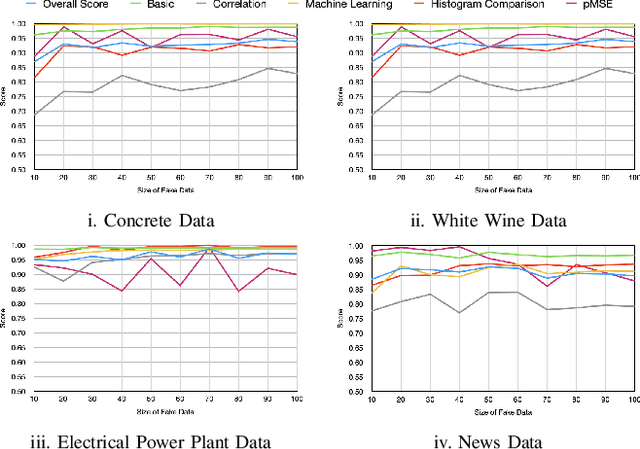
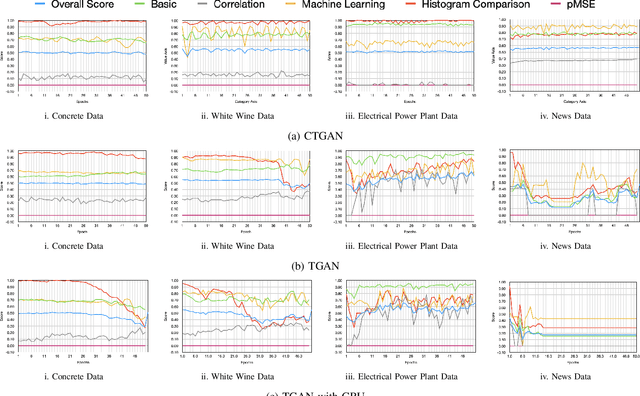
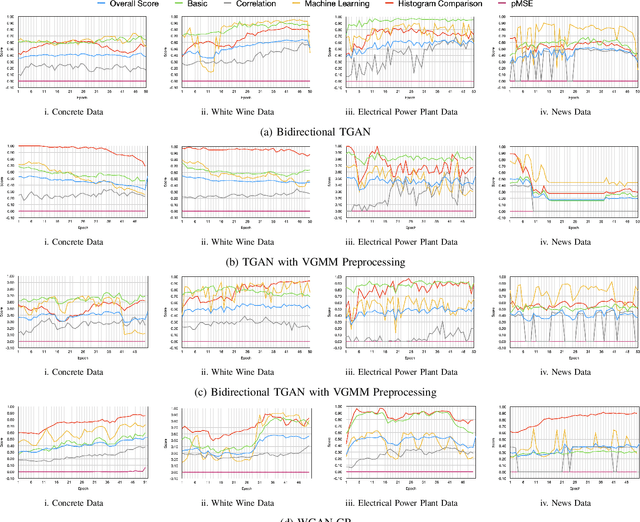
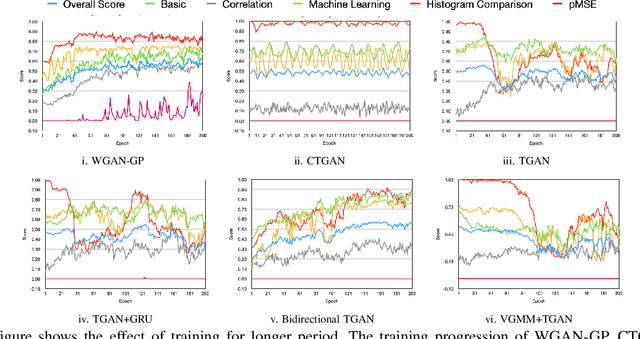
Abstract:Synthetic tabular data generation becomes crucial when real data is limited, expensive to collect, or simply cannot be used due to privacy concerns. However, producing good quality synthetic data is challenging. Several probabilistic, statistical, and generative adversarial networks (GANs) based approaches have been presented for synthetic tabular data generation. Once generated, evaluating the quality of the synthetic data is quite challenging. Some of the traditional metrics have been used in the literature but there is lack of a common, robust, and single metric. This makes it difficult to properly compare the effectiveness of different synthetic tabular data generation methods. In this paper we propose a new universal metric, TabSynDex, for robust evaluation of synthetic data. TabSynDex assesses the similarity of synthetic data with real data through different component scores which evaluate the characteristics that are desirable for "high quality" synthetic data. Being a single score metric, TabSynDex can also be used to observe and evaluate the training of neural network based approaches. This would help in obtaining insights that was not possible earlier. Further, we present several baseline models for comparative analysis of the proposed evaluation metric with existing generative models.
Learning to Enhance Visual Quality via Hyperspectral Domain Mapping
Feb 10, 2021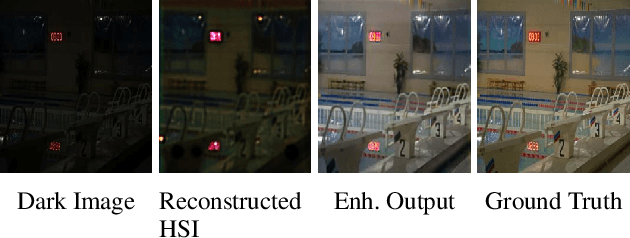
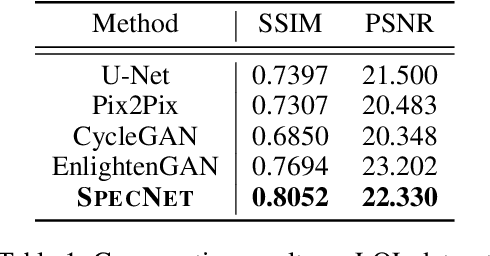
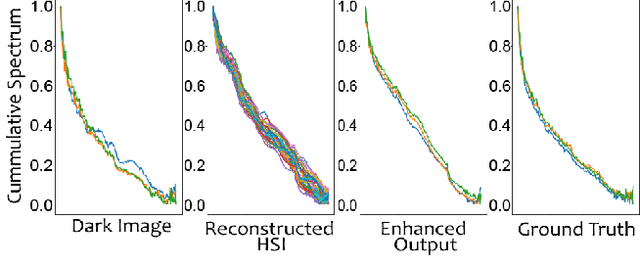
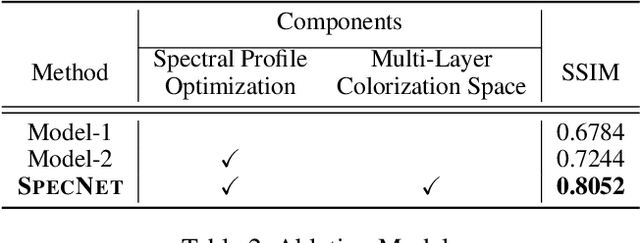
Abstract:Deep learning based methods have achieved remarkable success in image restoration and enhancement, but most such methods rely on RGB input images. These methods fail to take into account the rich spectral distribution of natural images. We propose a deep architecture, SpecNet, which computes spectral profile to estimate pixel-wise dynamic range adjustment of a given image. First, we employ an unpaired cycle-consistent framework to generate hyperspectral images (HSI) from low-light input images. HSI is further used to generate a normal light image of the same scene. We incorporate a self-supervision and a spectral profile regularization network to infer a plausible HSI from an RGB image. We evaluate the benefits of optimizing the spectral profile for real and fake images in low-light conditions on the LOL Dataset.
Improving Aerial Instance Segmentation in the Dark with Self-Supervised Low Light Enhancement
Feb 10, 2021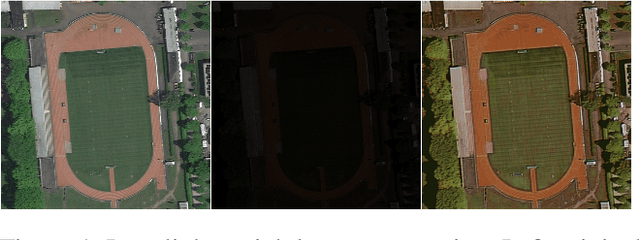



Abstract:Low light conditions in aerial images adversely affect the performance of several vision based applications. There is a need for methods that can efficiently remove the low light attributes and assist in the performance of key vision tasks. In this work, we propose a new method that is capable of enhancing the low light image in a self-supervised fashion, and sequentially apply detection and segmentation tasks in an end-to-end manner. The proposed method occupies a very small overhead in terms of memory and computational power over the original algorithm and delivers superior results. Additionally, we propose the generation of a new low light aerial dataset using GANs, which can be used to evaluate vision based networks for similar adverse conditions.
Domain-Aware Unsupervised Hyperspectral Reconstruction for Aerial Image Dehazing
Nov 07, 2020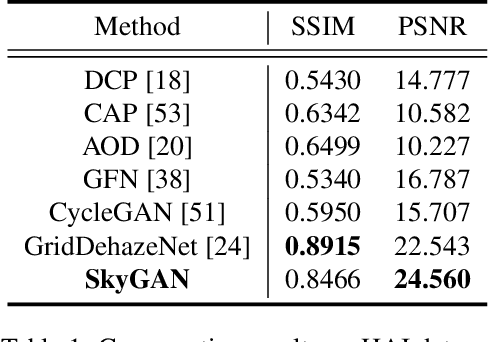

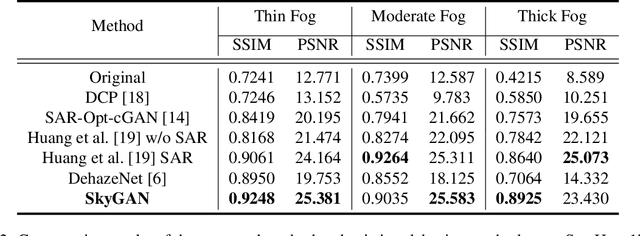

Abstract:Haze removal in aerial images is a challenging problem due to considerable variation in spatial details and varying contrast. Changes in particulate matter density often lead to degradation in visibility. Therefore, several approaches utilize multi-spectral data as auxiliary information for haze removal. In this paper, we propose SkyGAN for haze removal in aerial images. SkyGAN consists of 1) a domain-aware hazy-to-hyperspectral (H2H) module, and 2) a conditional GAN (cGAN) based multi-cue image-to-image translation module (I2I) for dehazing. The proposed H2H module reconstructs several visual bands from RGB images in an unsupervised manner, which overcomes the lack of hazy hyperspectral aerial image datasets. The module utilizes task supervision and domain adaptation in order to create a "hyperspectral catalyst" for image dehazing. The I2I module uses the hyperspectral catalyst along with a 12-channel multi-cue input and performs effective image dehazing by utilizing the entire visual spectrum. In addition, this work introduces a new dataset, called Hazy Aerial-Image (HAI) dataset, that contains more than 65,000 pairs of hazy and ground truth aerial images with realistic, non-homogeneous haze of varying density. The performance of SkyGAN is evaluated on the recent SateHaze1k dataset as well as the HAI dataset. We also present a comprehensive evaluation of HAI dataset with a representative set of state-of-the-art techniques in terms of PSNR and SSIM.
NTIRE 2020 Challenge on NonHomogeneous Dehazing
May 07, 2020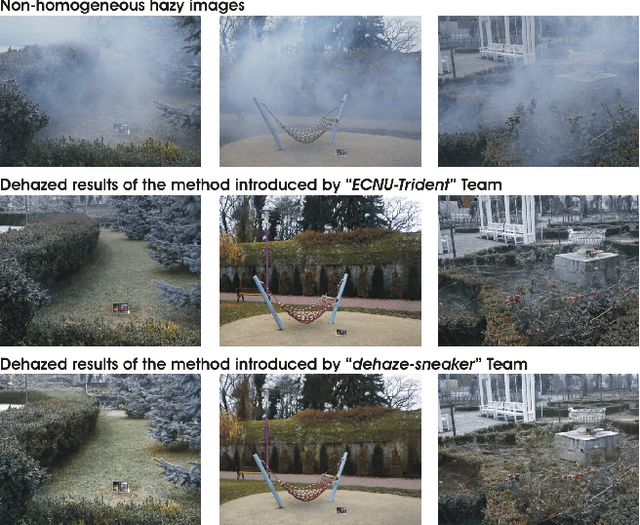
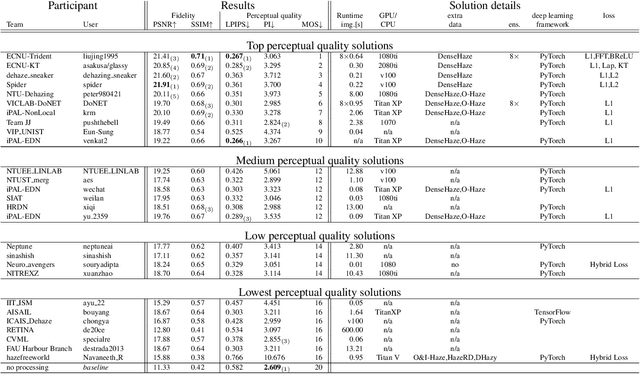
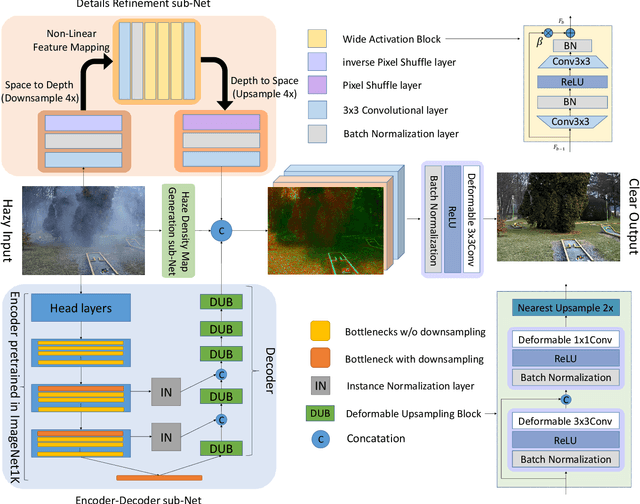
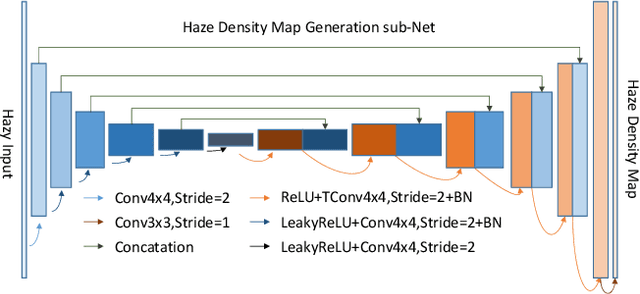
Abstract:This paper reviews the NTIRE 2020 Challenge on NonHomogeneous Dehazing of images (restoration of rich details in hazy image). We focus on the proposed solutions and their results evaluated on NH-Haze, a novel dataset consisting of 55 pairs of real haze free and nonhomogeneous hazy images recorded outdoor. NH-Haze is the first realistic nonhomogeneous haze dataset that provides ground truth images. The nonhomogeneous haze has been produced using a professional haze generator that imitates the real conditions of haze scenes. 168 participants registered in the challenge and 27 teams competed in the final testing phase. The proposed solutions gauge the state-of-the-art in image dehazing.
 Add to Chrome
Add to Chrome Add to Firefox
Add to Firefox Add to Edge
Add to Edge